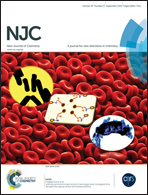The synthesis and characterization of lead sulfide with cube-like structure as a counter electrode in the presence of urea using a hydrothermal method†
Abstract
High-performance PbS particles with cube-like structure were deposited onto fluorine-doped tin oxide glass substrates using a hydrothermal method. The PbS particles were used as an efficient counter electrode (CE) for polysulfide redox reactions in CdS/CdSe quantum dot-sensitized solar cells (QDSSCs). The deposition time and urea concentration were optimized to prepare the PbS CEs. The morphology becomes smoother and the surface roughness increases with the 0.3 M urea CE, which was confirmed by field-emission scanning electron microscopy (FE-SEM) and atomic force microscopy (AFM). Under full sunlight illumination, QDSSCs with the optimized 0.3 M urea CE achieved an efficiency of 3.83% (Voc = 0.55 V, Jsc = 13.17 mA cm−2, and FF = 0.52). This value is higher than those for the 0 M urea cell (η = 2.47%, Jsc = 10.60 mA cm−2) and Pt-based cell (η = 1.32%, Jsc = 5.85 mA cm−2). Characterization by electrochemical impedance spectroscopy (EIS) and Tafel polarization indicated that the PbS cube-like CEs have lower charge transfer resistance at the CE/electrolyte interface (RCE) and superior electrochemical catalytic ability. However, RCE increased with increasing urea concentration (urea >0.3 M), and therefore, the fill factor decreased for the PbS CEs. The influence of different urea concentrations is discussed in detail.


 Please wait while we load your content...
Please wait while we load your content...